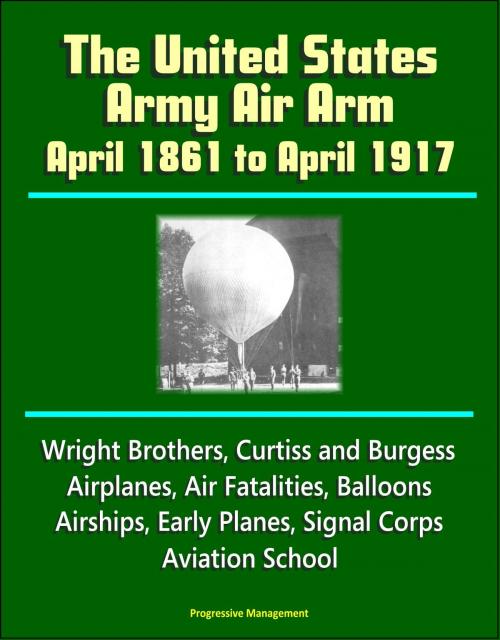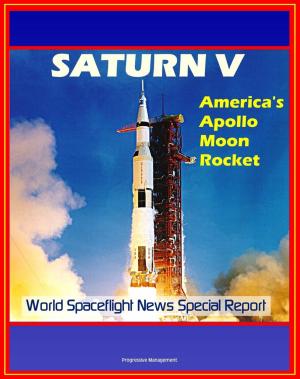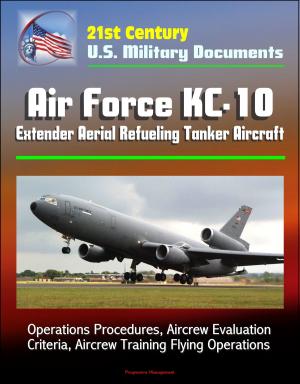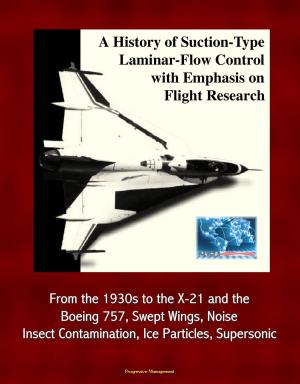The United States Army Air Arm: April 1861 to April 1917, Wright Brothers, Curtiss and Burgess Airplanes, Air Fatalities, Balloons, Airships, Early Planes, Signal Corps, Aviation School
Nonfiction, Science & Nature, Technology, Aeronautics & Astronautics, History, Military, Aviation| Author: | Progressive Management | ISBN: | 9781310652349 |
| Publisher: | Progressive Management | Publication: | May 7, 2014 |
| Imprint: | Smashwords Edition | Language: | English |
| Author: | Progressive Management |
| ISBN: | 9781310652349 |
| Publisher: | Progressive Management |
| Publication: | May 7, 2014 |
| Imprint: | Smashwords Edition |
| Language: | English |
This important official monograph recounts the development of aviation in the United States Army from April 1861, when the Army first became interested in balloons as a means of observation, to April 1917, when America entered World War I. The origins and organizations of the Army's air arm are told in detail, with particular emphasis on early air force personnel, planes, and experiments. In the process the monograph traces the early development of what today is The United States Air Force. Of necessity, the monograph tends strongly toward the chronological variety. This is owing to several factors, the thinness of aviation activities for most of the long period covered and an equal thinness in records being the principal factors. Only a few books which deal with this early period of Army aviation have been written, and all of them together do not cover the period. This, then, is the first attempt to put the story into a single volume. Because the story of the air arm from April 1917 to the beginning of World War II also has not been fully covered it is expected that the present monograph will be the first of three, which, when completed, will become the basis for a published history of the Army Air Arm, 1861-1939.
Chapter I - Balloons and Airships in the United States Army, 1861-1913 * Chapter II - Early American Planes and Their Inventors * Chapter III - The Signal Corps' First Air Installations and First Military Aviator Rating * Chapter IV - College Park and Other Air Schools, 1912-1913 * Chapter V - Signal Corps Aviation School at San Diego, 1913 to July 1914 * Chapter VI - Aviation Legislation, and the Aviation Section Through 1914 * Chapter VII - Aviation in 1915 and 1916 * Chapter VIII - The Aviation Section in 1916 * Chapter IX - The 1st Squadron with Pershing's Punitive Expedition, 1916 * Chapter X - Army Flying Training Schools, The National Guard, and The Air Reserve * Chapter XI - The Aviation Section to 6 April 1917
Chapter I * Balloons and Airships in the United States Army, 1861-1913 * Balloons in the Civil War The Spanish-American War Balloon * Ballooning in the United States Army, 1902-1914 * Chapter II * Early American Planes and Their Inventors * The Langley Plane * The Wright Brothers' Plane * Other Early Airplanes and Inventors * Chapter III * The Signal Corps' First Air Installations and First Military Aviator Rating * Fort Sam Houston, 1910-1911 * College Park, 1911 * Winter School at Augusta, Georgia, 1911-1912 * "Military Aviator" Rating * Chapter IV * College Park and Other Air Schools, 1912-1913 * College Park * The Augusta Air School, 1912-1913 * The Texas City Air School, 1913 * Overseas Air Schools: Philippines and Hawaii * Chapter V * Signal Corps Aviation School at San Diego, 1913 to July 1914 * Chapter VI * Aviation Legislation, and the Aviation Section Through 1914 * Legislative Action * The Aviation Section * Airplanes Purchased by the Signal Corps in 1914 * The San Diego School * Chapter VII * Aviation in 1915 and 1916 * The Aviation Section in 1915 * The National Advisory Committee for Aeronautics * The Aero Club of America and the National Guard in 1915-1916 * The First Aero Company of the National Guard in 1915-1916 * The Status of the American Aviation Industry in 1915 * Pyrotechnics Tested * Airplanes Accepted and Tested in 1915 * The San Diego School * The 1st Aero Squadron * San Antonio Air Center * The Philippine Squadron and Others — 1915 and 1916 * Chapter VIII * The Aviation Section in 1916 * Air Legislation * The Aviation Section * San Diego Developments * The Aviation Center at Fort Sam Houston * Reserve Corps Expansion * Balloons and Zeppelins * Division of Authority * Summary * Chapter IX * The 1st Squadron with Pershing's Punitive Expedition, 1916 * Chapter X * Army Flying Training Schools, The National Guard, and The Air Reserve * Army Flying Training Schools * The Flying School Program, April 1917
This important official monograph recounts the development of aviation in the United States Army from April 1861, when the Army first became interested in balloons as a means of observation, to April 1917, when America entered World War I. The origins and organizations of the Army's air arm are told in detail, with particular emphasis on early air force personnel, planes, and experiments. In the process the monograph traces the early development of what today is The United States Air Force. Of necessity, the monograph tends strongly toward the chronological variety. This is owing to several factors, the thinness of aviation activities for most of the long period covered and an equal thinness in records being the principal factors. Only a few books which deal with this early period of Army aviation have been written, and all of them together do not cover the period. This, then, is the first attempt to put the story into a single volume. Because the story of the air arm from April 1917 to the beginning of World War II also has not been fully covered it is expected that the present monograph will be the first of three, which, when completed, will become the basis for a published history of the Army Air Arm, 1861-1939.
Chapter I - Balloons and Airships in the United States Army, 1861-1913 * Chapter II - Early American Planes and Their Inventors * Chapter III - The Signal Corps' First Air Installations and First Military Aviator Rating * Chapter IV - College Park and Other Air Schools, 1912-1913 * Chapter V - Signal Corps Aviation School at San Diego, 1913 to July 1914 * Chapter VI - Aviation Legislation, and the Aviation Section Through 1914 * Chapter VII - Aviation in 1915 and 1916 * Chapter VIII - The Aviation Section in 1916 * Chapter IX - The 1st Squadron with Pershing's Punitive Expedition, 1916 * Chapter X - Army Flying Training Schools, The National Guard, and The Air Reserve * Chapter XI - The Aviation Section to 6 April 1917
Chapter I * Balloons and Airships in the United States Army, 1861-1913 * Balloons in the Civil War The Spanish-American War Balloon * Ballooning in the United States Army, 1902-1914 * Chapter II * Early American Planes and Their Inventors * The Langley Plane * The Wright Brothers' Plane * Other Early Airplanes and Inventors * Chapter III * The Signal Corps' First Air Installations and First Military Aviator Rating * Fort Sam Houston, 1910-1911 * College Park, 1911 * Winter School at Augusta, Georgia, 1911-1912 * "Military Aviator" Rating * Chapter IV * College Park and Other Air Schools, 1912-1913 * College Park * The Augusta Air School, 1912-1913 * The Texas City Air School, 1913 * Overseas Air Schools: Philippines and Hawaii * Chapter V * Signal Corps Aviation School at San Diego, 1913 to July 1914 * Chapter VI * Aviation Legislation, and the Aviation Section Through 1914 * Legislative Action * The Aviation Section * Airplanes Purchased by the Signal Corps in 1914 * The San Diego School * Chapter VII * Aviation in 1915 and 1916 * The Aviation Section in 1915 * The National Advisory Committee for Aeronautics * The Aero Club of America and the National Guard in 1915-1916 * The First Aero Company of the National Guard in 1915-1916 * The Status of the American Aviation Industry in 1915 * Pyrotechnics Tested * Airplanes Accepted and Tested in 1915 * The San Diego School * The 1st Aero Squadron * San Antonio Air Center * The Philippine Squadron and Others — 1915 and 1916 * Chapter VIII * The Aviation Section in 1916 * Air Legislation * The Aviation Section * San Diego Developments * The Aviation Center at Fort Sam Houston * Reserve Corps Expansion * Balloons and Zeppelins * Division of Authority * Summary * Chapter IX * The 1st Squadron with Pershing's Punitive Expedition, 1916 * Chapter X * Army Flying Training Schools, The National Guard, and The Air Reserve * Army Flying Training Schools * The Flying School Program, April 1917















